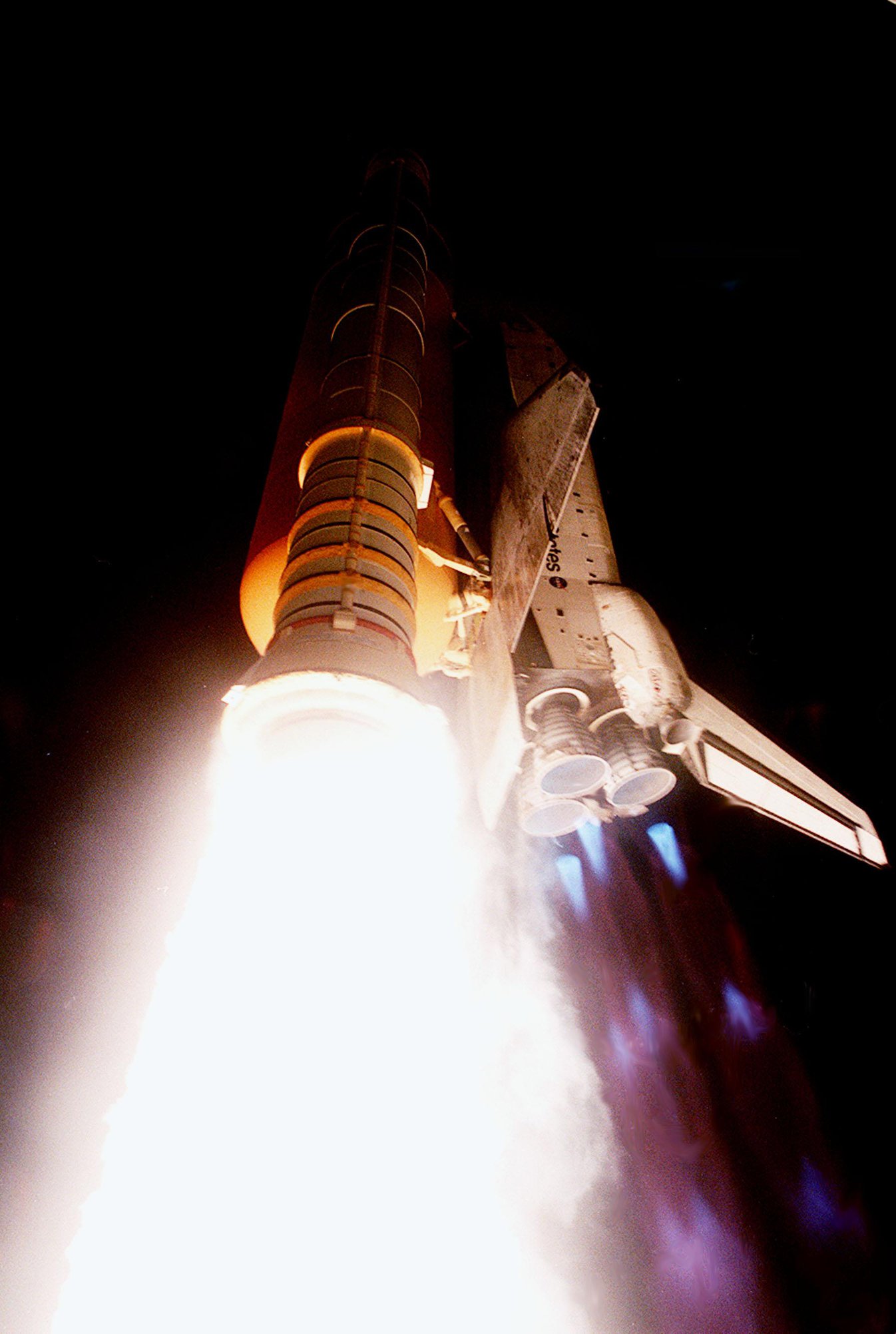
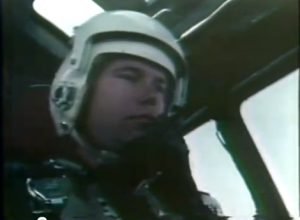
19 May 1976: A Strategic Air Command Boeing B-52D Stratofortress eight-engine bomber took off from Carswell Air Force Base, Fort Worth, Texas on a training flight. As the airplane’s landing gear was retracting, the hydraulic system failed leaving the right front gear with its 2-wheel bogie partially retracted and unlocked. The hydraulic system failure also disabled the B-52’s steering, brakes and rudder. Captain James A. Yule, an Instructor Pilot, took command of the aircraft. SAC headquarters at Omaha, Nebraska, diverted the airplane to Edwards Air Force Base in California so that the bomber could land on the large dry lake bed there.
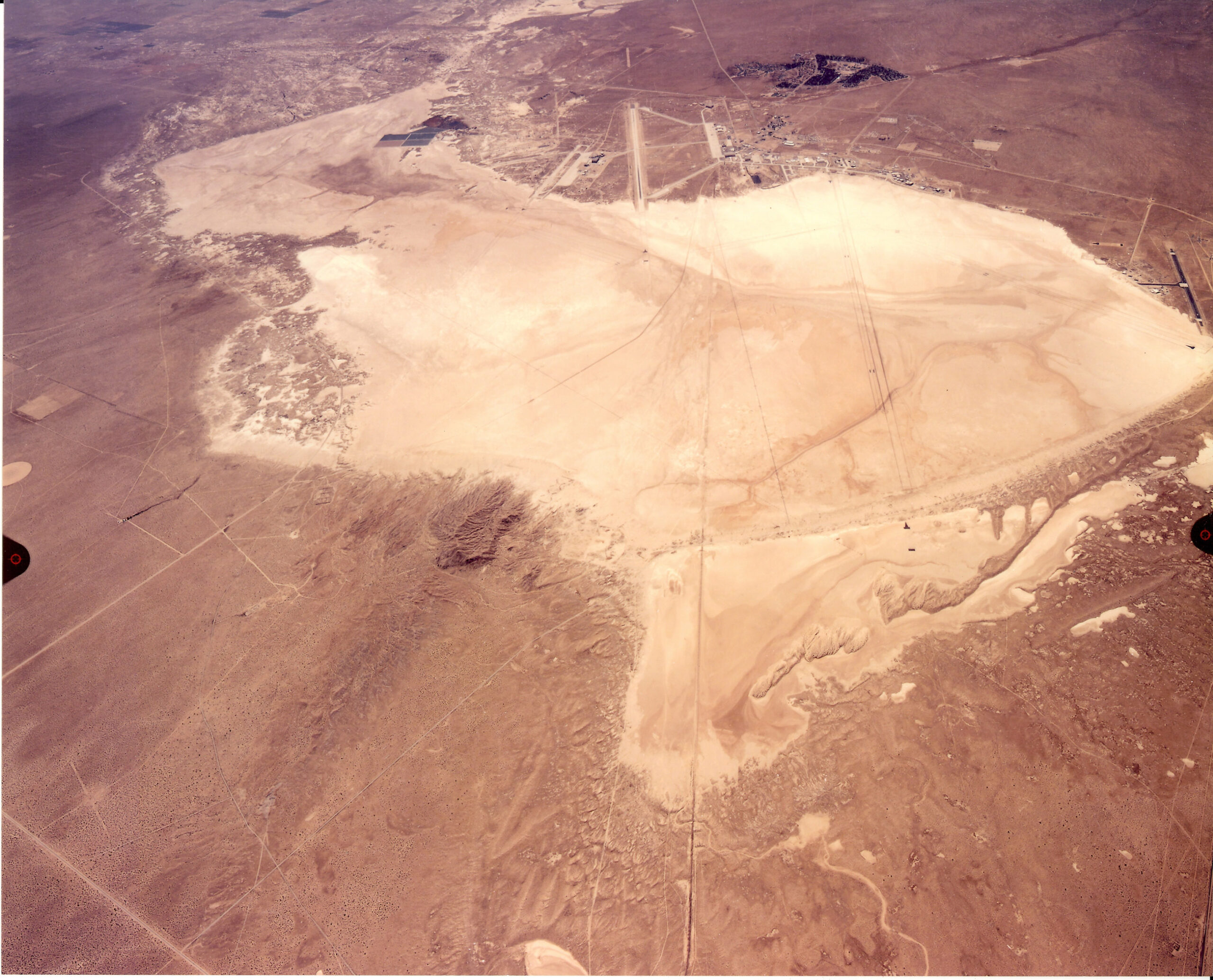
After a five-hour flight and making several practice approaches, Captain Yule landed the aircraft. With no brakes, it coasted for two-and-a-half miles before coming to a stop. During the roll out, the right front bogie bounced up and down, providing no support. However, with the limited control available, Captain Yule successfully landed the Stratofortress with no damage and no injuries to the crew. He and another pilot received the Air Medal, and the rest of the air crew were awarded the Air Force Commendation Medal.
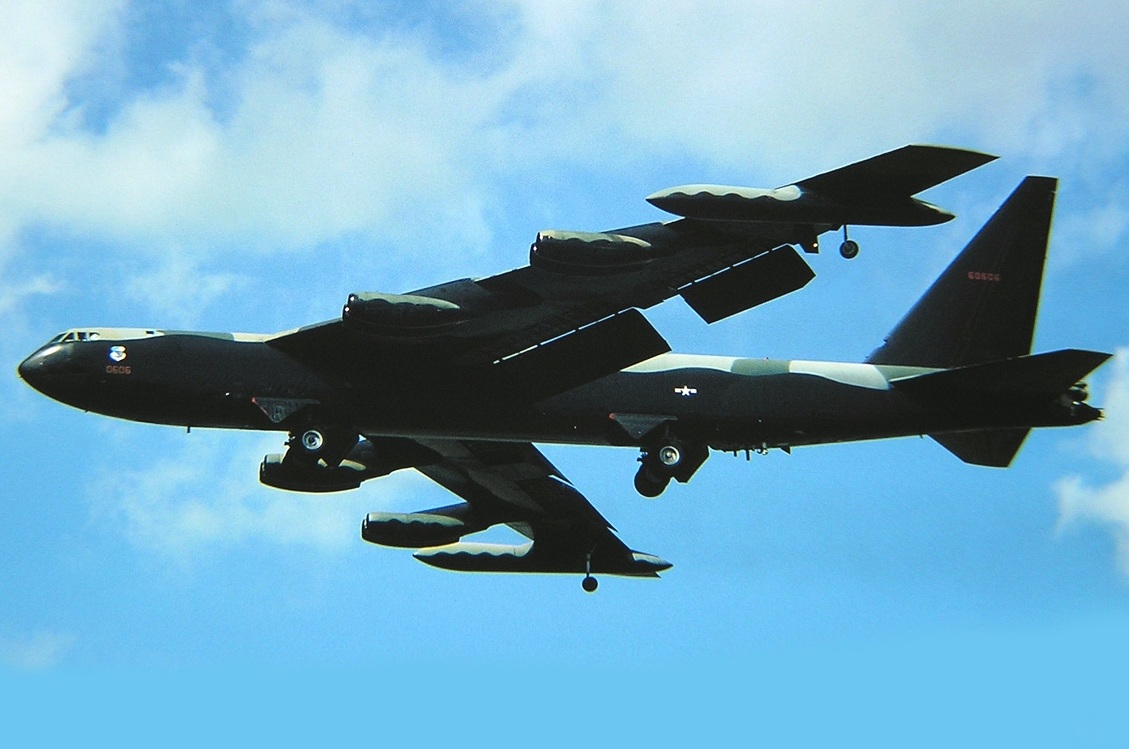
Captain Yule was the recipient of the Mackay Trophy for 1976. Established in 1911 and administered by the National Aeronautic Association, the Mackay Trophy is awarded to the “most meritorious flight of the year” by an Air Force person, persons, or organization. His citation reads:
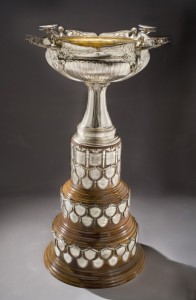
“For gallantry and unusual presence of mind while participating in a flight as an instructor pilot of a B-52D Stratofortress.
“Captain James A Yule, distinguished himself by gallantry and unusual presence of mind while participating in an aerial flight as an instructor pilot of a B-52D aircraft on 19 May 1976. Captain Yule’s flight developed a unique multiple emergency and he assumed command of the aircraft, and at great personal risk, checked out the hydraulic open wheel well area to detect the problem. Using initiative, he coordinated with ground agencies and crew members and determined that a safe landing could be made after loss of braking and complete failure of steering. Captain Yule’s professional competence and outstanding airmanship under extreme stress resulted in successful recovery of the crew and a valuable aircraft. His courageous acts in landing a malfunctioning aircraft reflect great credit upon himself and the United States Air Force.”
© 2015, Bryan R. Swopes
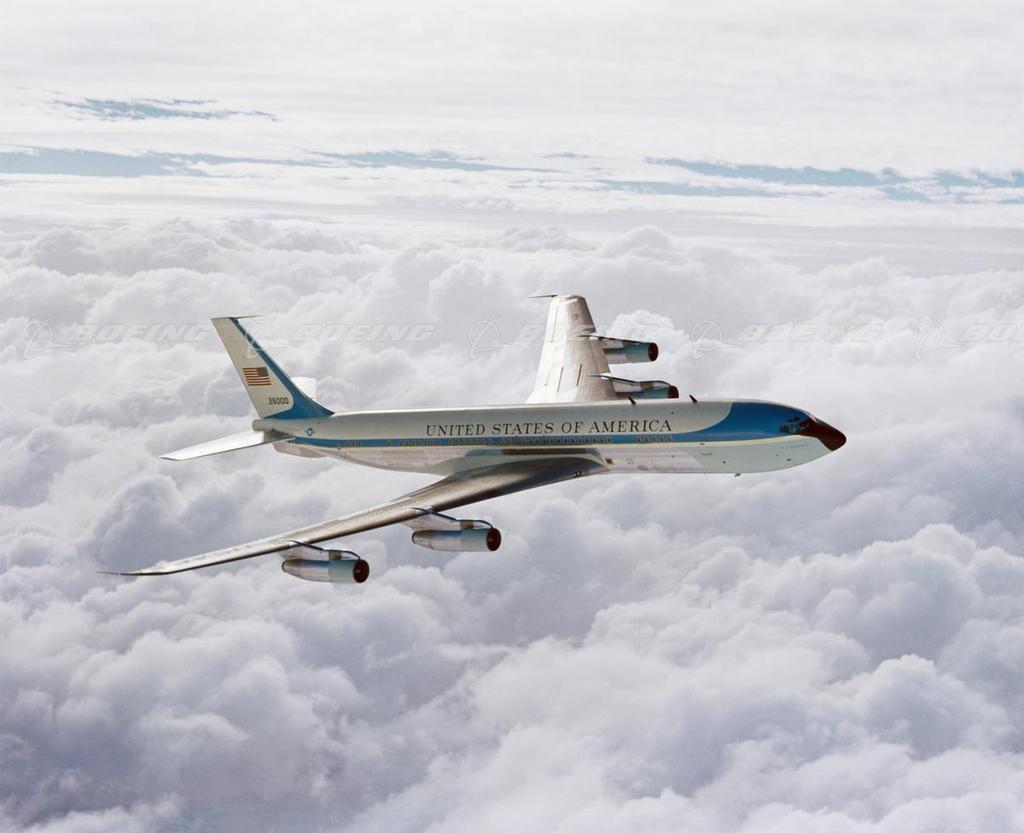
 19 May 1963: During a non-stop flight from Andrews Air Force Base, outside Washington, D.C., to Moscow, Russia, Union of Soviet Socialist Republics, a Boeing VC-137C, 62-6000, under the command of Colonel James B. Swindal, United States Air Force, set 15 Fédération Aéronautique Internationale (FAI) World Records for Speed Over a Recognized Course. Colonel Swindal flew the airplane, commonly known as Air Force One, 5,004 miles (8,053.2 kilometers) in 8 hours, 39 minutes, 2 seconds, averaging 490.96 miles per hour (790.12 kilometers per hour). On the return flight, 15 additional records were set.
19 May 1963: During a non-stop flight from Andrews Air Force Base, outside Washington, D.C., to Moscow, Russia, Union of Soviet Socialist Republics, a Boeing VC-137C, 62-6000, under the command of Colonel James B. Swindal, United States Air Force, set 15 Fédération Aéronautique Internationale (FAI) World Records for Speed Over a Recognized Course. Colonel Swindal flew the airplane, commonly known as Air Force One, 5,004 miles (8,053.2 kilometers) in 8 hours, 39 minutes, 2 seconds, averaging 490.96 miles per hour (790.12 kilometers per hour). On the return flight, 15 additional records were set.
The fastest segment of the flight was from to Boston, Massachusetts to Oslo, Norway, at an average speed of 952.62 kilometers per hour (591.93 miles per hour).¹
The New York Times reported:
MOSCOW — President Kennedy’s Air Force jet today set a nonstop speed record between Washington and Moscow and shattered 14 other air records. The $8 million Boeing 707, carrying a ten-man party headed by Atomic Energy Commission chairman Glenn T. Seaborg, touched down eight hours 38 minutes and 42 seconds after takeoff — the fastest flight ever made between the U.S. and the Soviet Union. Interred was a Soviet myth that the U.S. lacked a plane able to make a 5,000-mile run nonstop. The black-nosed blue and white jet, piloted by Col. James B. Swindal, 46, of Falls Church, Virginia, made it with fuel for more than two hours of flight remaining, proving that any delays in reaching a commercial agreement are political, not technical.
— The New York Times, 19 May 1963
The Washington Post reported that
. . . On board were a Soviet navigator and a Soviet radio operator, the usual requirements for all international flights over Soviet territory. The two men, both speaking English, flew to Washington to make the flight.
— The Washington Post, 20 May 1963
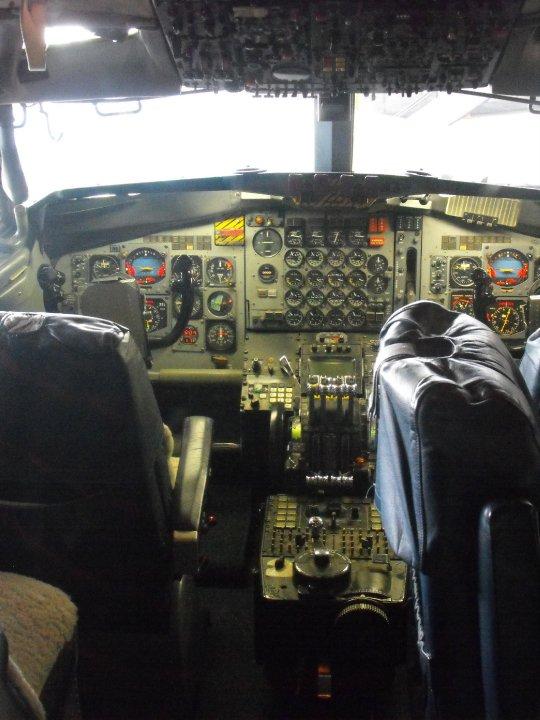
![]() The Boeing VC-137C was the first of two specially-configured Boeing 707-353B airliners used by the President of the United States, or other senior administration officials. The distinctive white, blue and natural metal livery was created by the famed industrial designer Raymond Loewy.
The Boeing VC-137C was the first of two specially-configured Boeing 707-353B airliners used by the President of the United States, or other senior administration officials. The distinctive white, blue and natural metal livery was created by the famed industrial designer Raymond Loewy.
When the president is aboard, the airplane is designated “Air Force One”. At other times, it uses the Special Air Mission designation, SAM 26000. The airplane entered service in 1962, replacing the three earlier commercial Boeing 707-153 airliners, which were designated VC-137A Stratoliner, USAF serial numbers 58-6970–58-6972.
SAM 26000 was itself replaced by SAM 27000 in 1972, though it remained available as a back-up aircraft. It was retired to the National Museum of the United States Air Force on 20 May 1998.
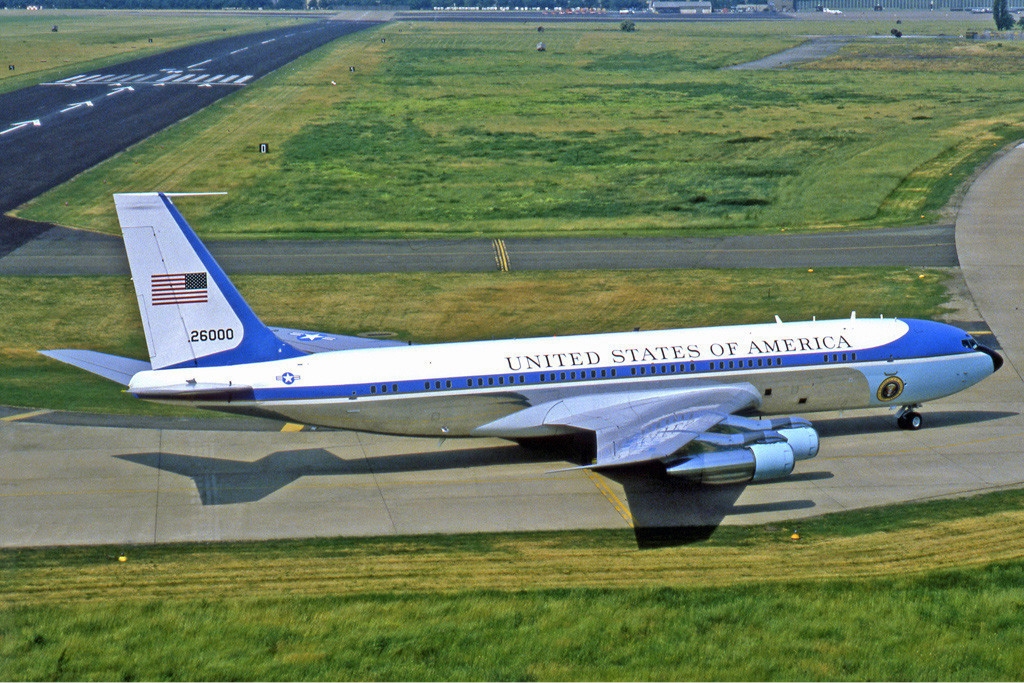
James Barney Swindal was born 18 August 1917 in West Blocton, Alabama. He was the first of two children of Samuel Young Swindal, a carpenter, and Ida Maranda Kornegay Swindal.
James Barney Swindal married Miss Emily Mae Glover on 18 November 1936, at Birmingham, Alabama. They would have two children. He was employed as a crane operator for a cast iron pipe company in Birmingham.
Swindal enlisted as an aviation cadet in the U.S. Army at Montgomery, Alabama, 28 February 1942, shortly after the United States entered World War II. He was blonde with blue eyes, 5 feet, 11 inches (1.80 meters) tall, and weighed 147 pounds (67 kilograms). Trained as a pilot in the U.S. Army Air Forces, he flew transports in the China-Burma-India (CBI) theater of operations. After the War, he participated in the Berlin Airlift.
Swindal became President Kennedy’s personal pilot in 1960. He flew JFK to Berlin for his famous “Ich bin ein Berliner” speech, 26 June 1963, and later flew President Kennedy’s casket from Dallas, Texas to Washington, D.C. Colonel Swindal retired from the Air Force in 1971. When SAM 26000 arrived at the National Museum of the United States Air Force, he sat in its cockpit for a last time.
Colonel Swindal died at Cape Canaveral, Florida, 25 April 2006, at the age of 88 years. He was buried at the Arlington National Cemetery, Arlington, Virginia.
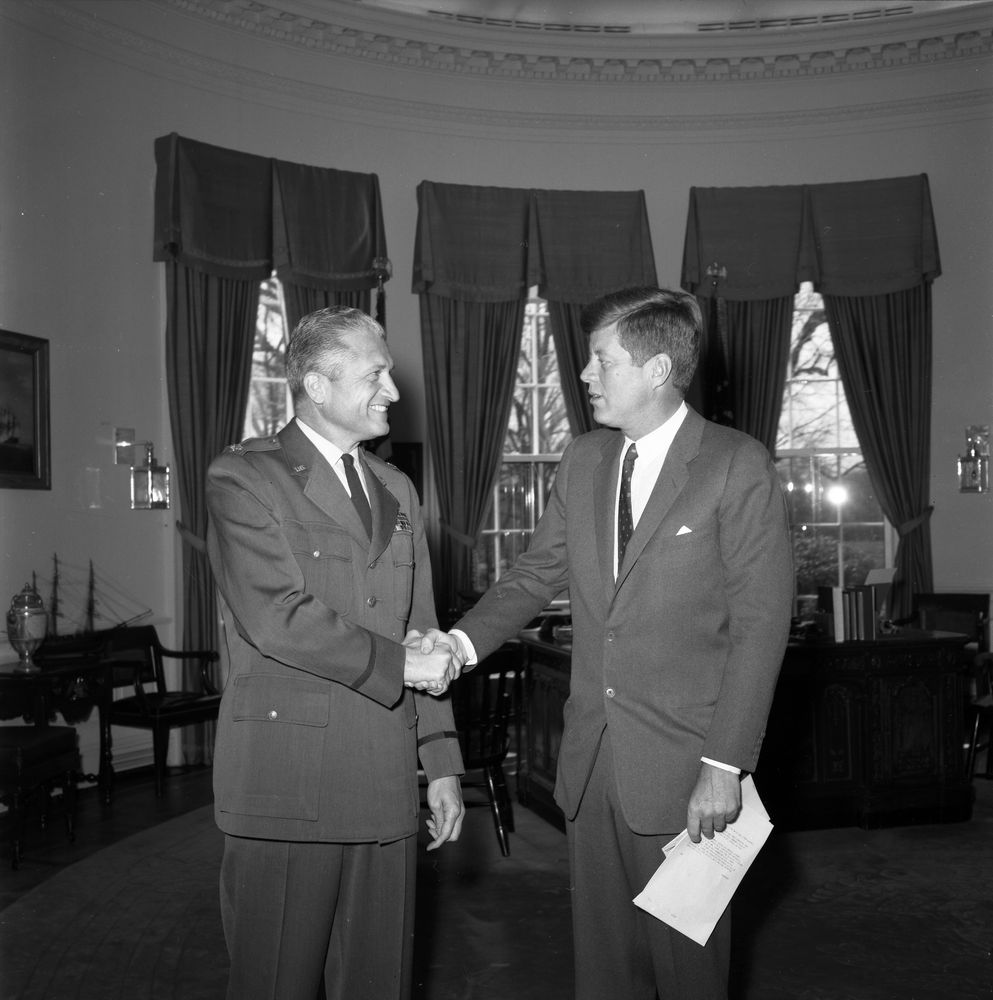
¹ FAI Record File Number 16472
© 2018, Bryan R. Swopes
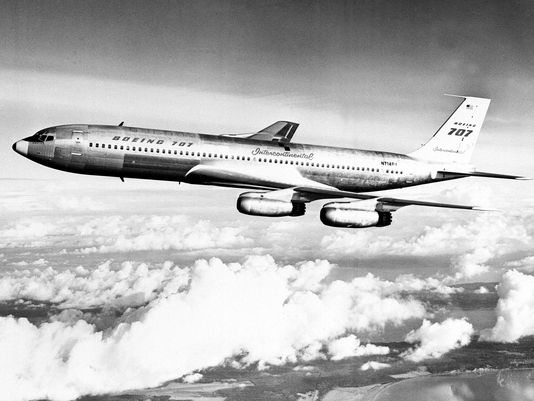
![]() 19 May 1959: The first Boeing 707-436 Intercontinental, FAA registration N31241, made a 1 hour, 11 minute first flight from Renton to Boeing Field, Seattle, Washington. The -436 was a stretched version of the original 707-120, but with Rolls-Royce Conway 508 bypass turbojet engines (now called turbofans) in place of the standard Pratt & Whitney JT3C-6 turbojet engines.
19 May 1959: The first Boeing 707-436 Intercontinental, FAA registration N31241, made a 1 hour, 11 minute first flight from Renton to Boeing Field, Seattle, Washington. The -436 was a stretched version of the original 707-120, but with Rolls-Royce Conway 508 bypass turbojet engines (now called turbofans) in place of the standard Pratt & Whitney JT3C-6 turbojet engines.
The fuselage and wings of the Intercontinental were lengthened, allowing an increased load and greater fuel capacity. It could carry 189 passengers and had a range 1,600 miles further than the -120. Transoceanic flights without an intermediate fuel stop were possible.
This airplane was the first of 15 which had been ordered by British Overseas Airways Corporation in 1956. It was re-registered G-APFB and delivered to BOAC 9 May 1960.
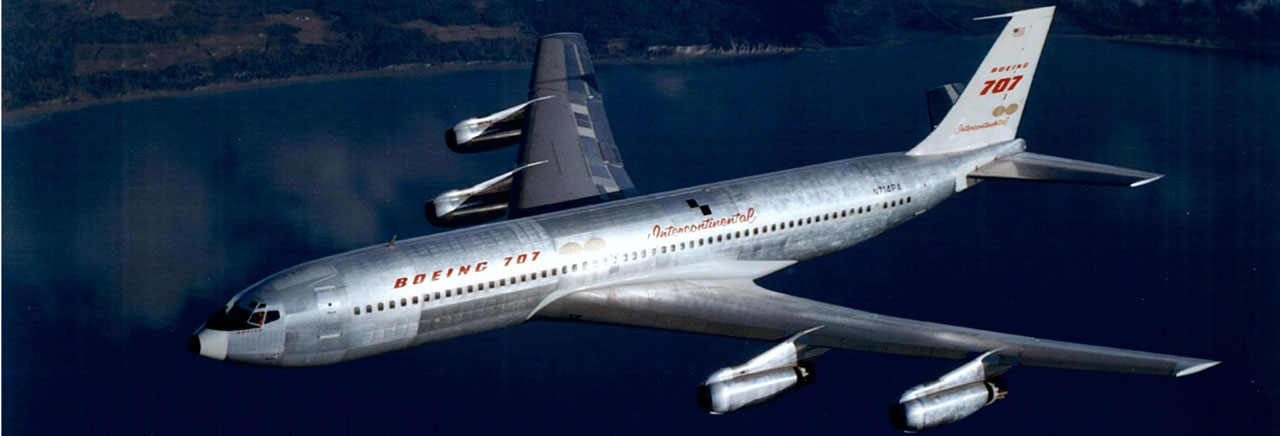
Initially, British aviation authorities refused to certify the -436 because of low-speed handling concerns. Boeing increased the height of the vertical fin 40 inches and added a ventral fin. These modifications became standard on all future 707s and were retro-fitted to those already manufactured.
G-APFB served BOAC until 1974, and then with other airlines. It was sold to Boeing Commercial Airplane Company in 1976. The forward fuselage and cabin was shipped to Renton for use in Boeing’s E-3A Sentry program. The remainder of the airliner was scrapped in 1978.
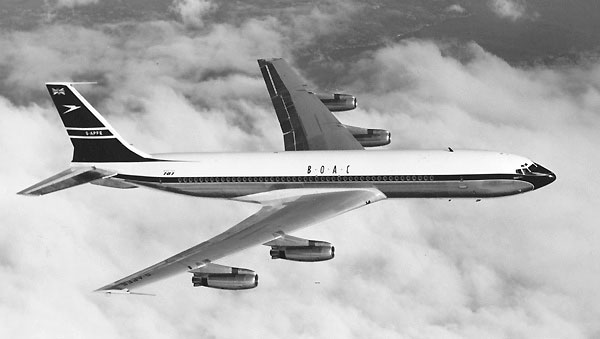
The Boeing 707-420 series airliners were 152 feet, 11 inches (46.609 meters) long, with a wingspan of 142 feet, 5 inches (43.409 meters) and overall height 42 feet, 2 inches (12.852 meters) at its operating empty weight. The leading edges of the wings and tail surfaces are swept 35°. The fuselage has a maximum diameter of 12 feet, 8.0 inches (3.759 meters). The 707 International has a typical empty weight of 142,600 pounds (64,682 kilograms), and a maximum takeoff weight (MTOW) of 312,000 pounds (141,700 kilograms). The usable fuel capacity is 23,820 gallons (90,169 liters).
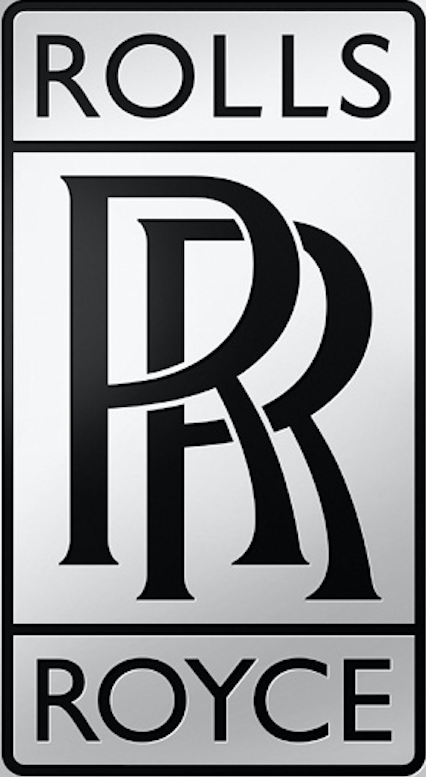 All 707-series aircraft are powered by four jet engines installed in nacelles below and forward of the wings on pylons. The -420 Internationals were powered by Rolls-Royce Conway Mk. 508 engines. The Rolls-Royce Conway (R.Co.12) is a two-spool, axial-flow, low-bypass turbofan engine. The engine has a 7-stage low- and 9-stage high-pressure compressor section, 12 interconnected combustion liners, with a single-stage high- and 2-stage low-pressure turbine. The Mk. 508 has a Maximum Continuous Power rating of 14,625 pounds of thrust (65.055 Kilonewtons), and 17,500 pounds of thrust (77.844 Kilonewtons) at 9,990 r.p.m., for Takeoff. The engine is 3 feet, 6.0 inches (1.067 meters) in diameter, 11 feet, 4.0 inches (3.454 meters) long, and weighs 4,542 pounds (2,060 kilograms).
All 707-series aircraft are powered by four jet engines installed in nacelles below and forward of the wings on pylons. The -420 Internationals were powered by Rolls-Royce Conway Mk. 508 engines. The Rolls-Royce Conway (R.Co.12) is a two-spool, axial-flow, low-bypass turbofan engine. The engine has a 7-stage low- and 9-stage high-pressure compressor section, 12 interconnected combustion liners, with a single-stage high- and 2-stage low-pressure turbine. The Mk. 508 has a Maximum Continuous Power rating of 14,625 pounds of thrust (65.055 Kilonewtons), and 17,500 pounds of thrust (77.844 Kilonewtons) at 9,990 r.p.m., for Takeoff. The engine is 3 feet, 6.0 inches (1.067 meters) in diameter, 11 feet, 4.0 inches (3.454 meters) long, and weighs 4,542 pounds (2,060 kilograms).
The -420 series had a maximum cruise speed of 593 miles per hour 954 kilometers per hour) at 30,000 feet (9,144 meters)—0.87 Mach; and economical cruise speed of 550 miles per hour (885 kilometers per hour) at 35,000 feet (10668 meters).
Boeing built 1,010 Model 707 airplanes between 1957 and 1979. Of these, 37 were the 707-420 Intercontinental variant.
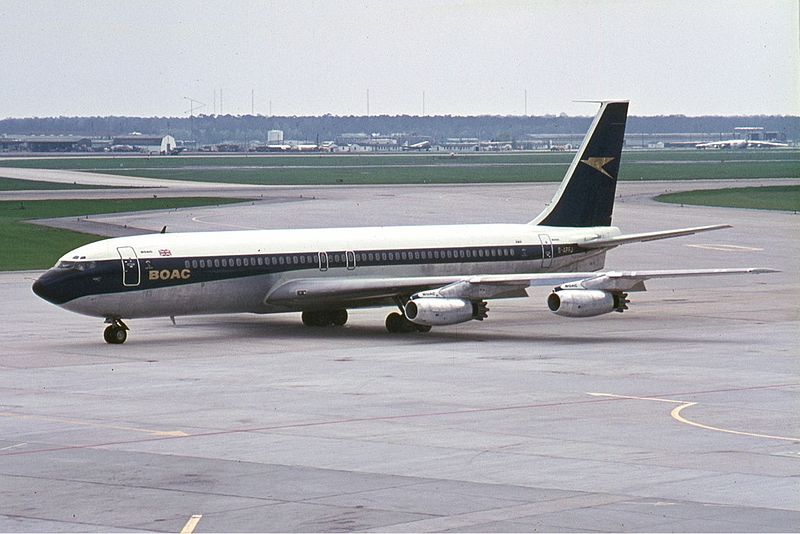
© 2018, Bryan R. Swopes
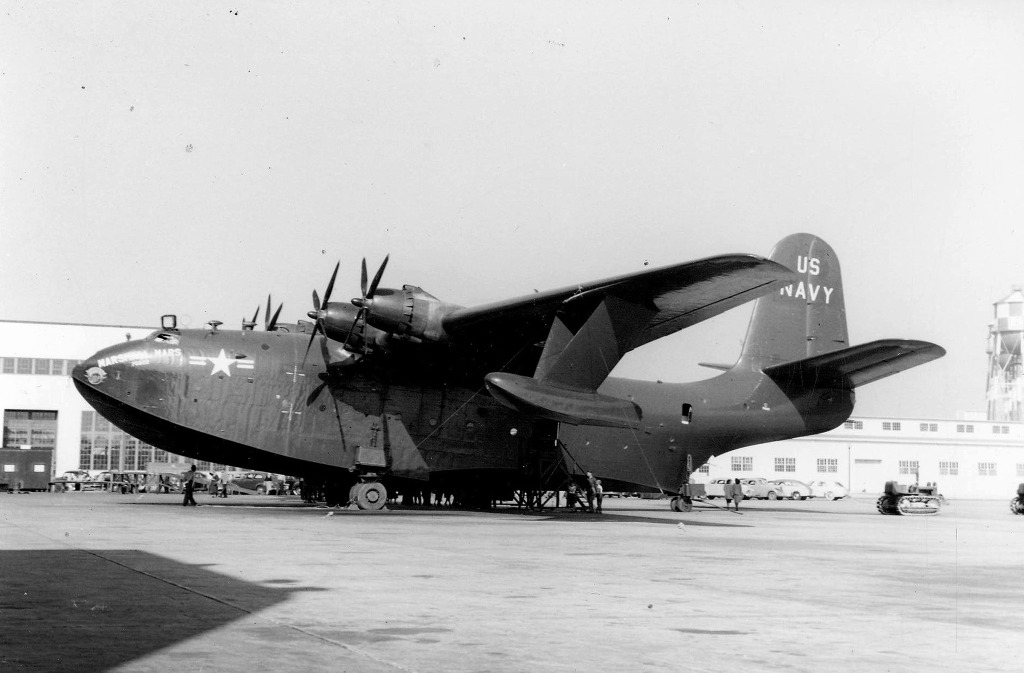
19 May 1949: Martin JRM-3 Mars, Marshall Mars, United States Navy Bureau of Aeronautics serial number (Bu. No.) 76822 flew from the Alameda Naval Air Station on the east shore of San Francisco Bay, to San Diego Bay, a distance of approximately 450 miles (725 kilometers). On board, in addition to the flight crew of 7, were 301 passengers.
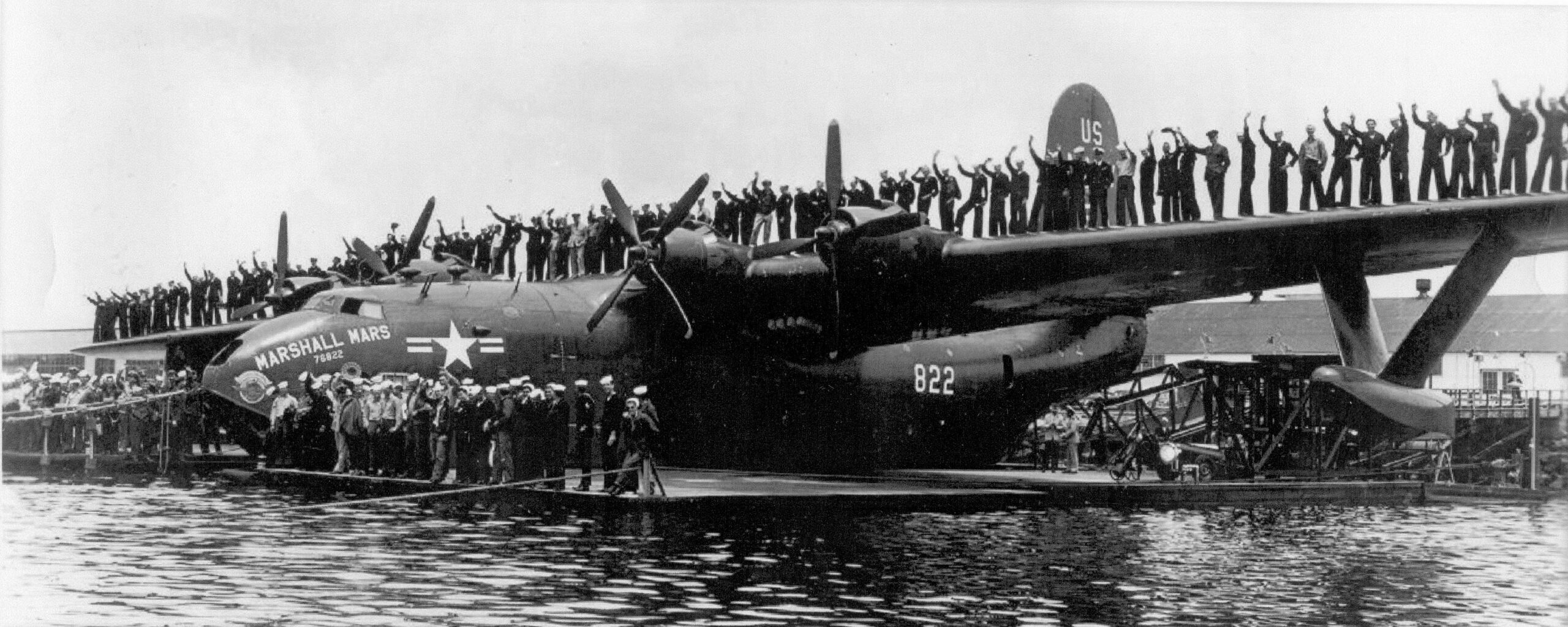
The Associated Press wire service reported the story:
NAVY’S BIG FLYING BOAT MARSHALL MARS CARRIES 301 PERSONS
SAN FRANCISCO, May 19—(AP)—The Navy’s big flying boat Marshall Mars carried a record load of 301 passengers—plus seven crewmen—on a flight to San Diego today.
It had never carried more than 269 passengers before.
The 1:52 p.m. takeoff, from the naval air station at Alameda, across the bay, was uneventful.
Today’s passengers are personnel of Air Group 5, Alameda Naval Air Station, who are being transferred to San Diego. Mattresses on the floor were provided for men unable to find seats.
—Wilmington Morning Star, Friday, 20 May 1949, Page 1, Column 4.
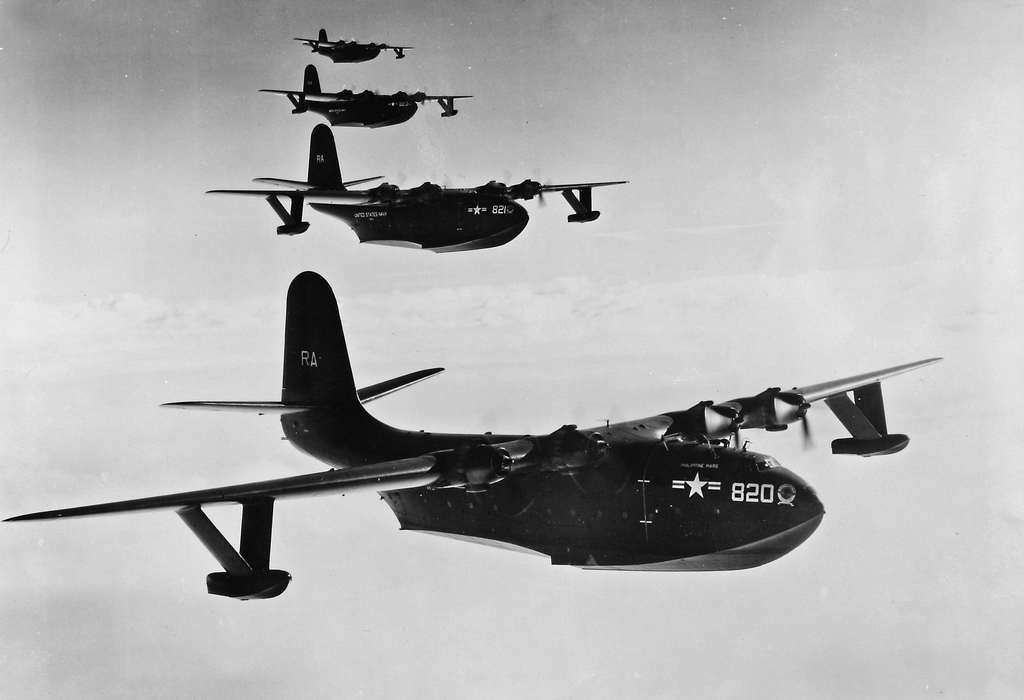
 The Martin JRM Mars was a large four-engine flying boat transport built by the Glenn L. Martin Company for the U. S. Navy. Only five were built, four designated JRM-1, with the last one being a JRM-2. Each airplane was given an individual name derived from the names of island chains in the Pacific Ocean: Marianas Mars, Hawaii Mars, Philippine Mars, Marshall Mars and Caroline Mars. These airplanes were used to transport personnel and cargo between the West Coast of the United States and the Hawaiian Islands. All were upgraded to JRM-3.
The Martin JRM Mars was a large four-engine flying boat transport built by the Glenn L. Martin Company for the U. S. Navy. Only five were built, four designated JRM-1, with the last one being a JRM-2. Each airplane was given an individual name derived from the names of island chains in the Pacific Ocean: Marianas Mars, Hawaii Mars, Philippine Mars, Marshall Mars and Caroline Mars. These airplanes were used to transport personnel and cargo between the West Coast of the United States and the Hawaiian Islands. All were upgraded to JRM-3.
The Martin JRM-3 Mars had a normal crew of 4, with accommodations for a relief crew. It was designed to carry 133 combat troops or 32,000 pounds (14,515 kilograms) of cargo. It was 120 feet, 3 inches (36.652 meters) long with a wingspan of 200 feet (60.960 meters) and height of 38 feet, 5 inches (11.709 meters). The flying boat had an empty weight of 80,701 pounds (36,605.4 kilograms). The maximum takeoff weight (MTOW) was 165,000 pounds (74,842.7 kilograms).
A NASA publication states, “A zero-lift drag coefficient of 0.0233 and a maximum lift-drag ratio of 16.4 made the JRM the most aerodynamically efficient of any of of the flying boats. . . .”
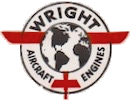 The Martin Mars was powered by four air-cooled, supercharged, direct-fuel-injected, 3,347.662-cubic-inch-displacement (54.858 liter) Wright Aeronautical Division R-3350-24WA (Cyclone 18 825C18BD1) (also known as the Duplex-Cyclone), a two-row 18-cylinder radial engines with a compression ratio of 6.70:1 and water/alcohol injection. This engine has a normal power rating of 2,000 horsepower at 2,400 r.p.m at 5,500 feet (1,676 meters) and 1,800 horsepower at 2,400 r.p.m. at 15,000 feet (4,572 meters). The engine’s takeoff power rating is 2,500 horsepower at 2,900 r.p.m. 100/130 octane aviation gasoline was required. The engines drove four-bladed 16 foot, 8 inch (5.080 meter) Curtiss Electric variable-pitch propellers through a 0.375:1 gear reduction. (After modification to the JRM-3, the propellers on the inboard engines were reversible.) The R-3350-24WA is 6 feet, 8.58 inches (2.047 meters) long, and 4 feet, 6.13 inches (1.375 meters) in diameter. Its dry weight is 2,822 pounds (1,280 kilograms).
The Martin Mars was powered by four air-cooled, supercharged, direct-fuel-injected, 3,347.662-cubic-inch-displacement (54.858 liter) Wright Aeronautical Division R-3350-24WA (Cyclone 18 825C18BD1) (also known as the Duplex-Cyclone), a two-row 18-cylinder radial engines with a compression ratio of 6.70:1 and water/alcohol injection. This engine has a normal power rating of 2,000 horsepower at 2,400 r.p.m at 5,500 feet (1,676 meters) and 1,800 horsepower at 2,400 r.p.m. at 15,000 feet (4,572 meters). The engine’s takeoff power rating is 2,500 horsepower at 2,900 r.p.m. 100/130 octane aviation gasoline was required. The engines drove four-bladed 16 foot, 8 inch (5.080 meter) Curtiss Electric variable-pitch propellers through a 0.375:1 gear reduction. (After modification to the JRM-3, the propellers on the inboard engines were reversible.) The R-3350-24WA is 6 feet, 8.58 inches (2.047 meters) long, and 4 feet, 6.13 inches (1.375 meters) in diameter. Its dry weight is 2,822 pounds (1,280 kilograms).
The JRM-3 had a cruise speed of 135 knots (155 miles per hour/250 kilometers per hour) and a maximum speed of 211 knots (243 miles per hour/391 kilometers per hour) at 15,600 feet (4,755 meters). The service ceiling was 19,700 feet (6,005 meters) and its range was 3,790 nautical miles (4,361 miles per hour/7,019 kilometers) at 135 knots.
On 5 April 1950, Marshall Mars had an engine fire and made an emergency landing off Diamond Head, Hawaii. The crew was rescued but the airplane exploded and sank. The wreck was discovered on the sea floor in August 2004.
The remaining airplanes were later converted to fire fighting airplanes in Canada. Only two remain.
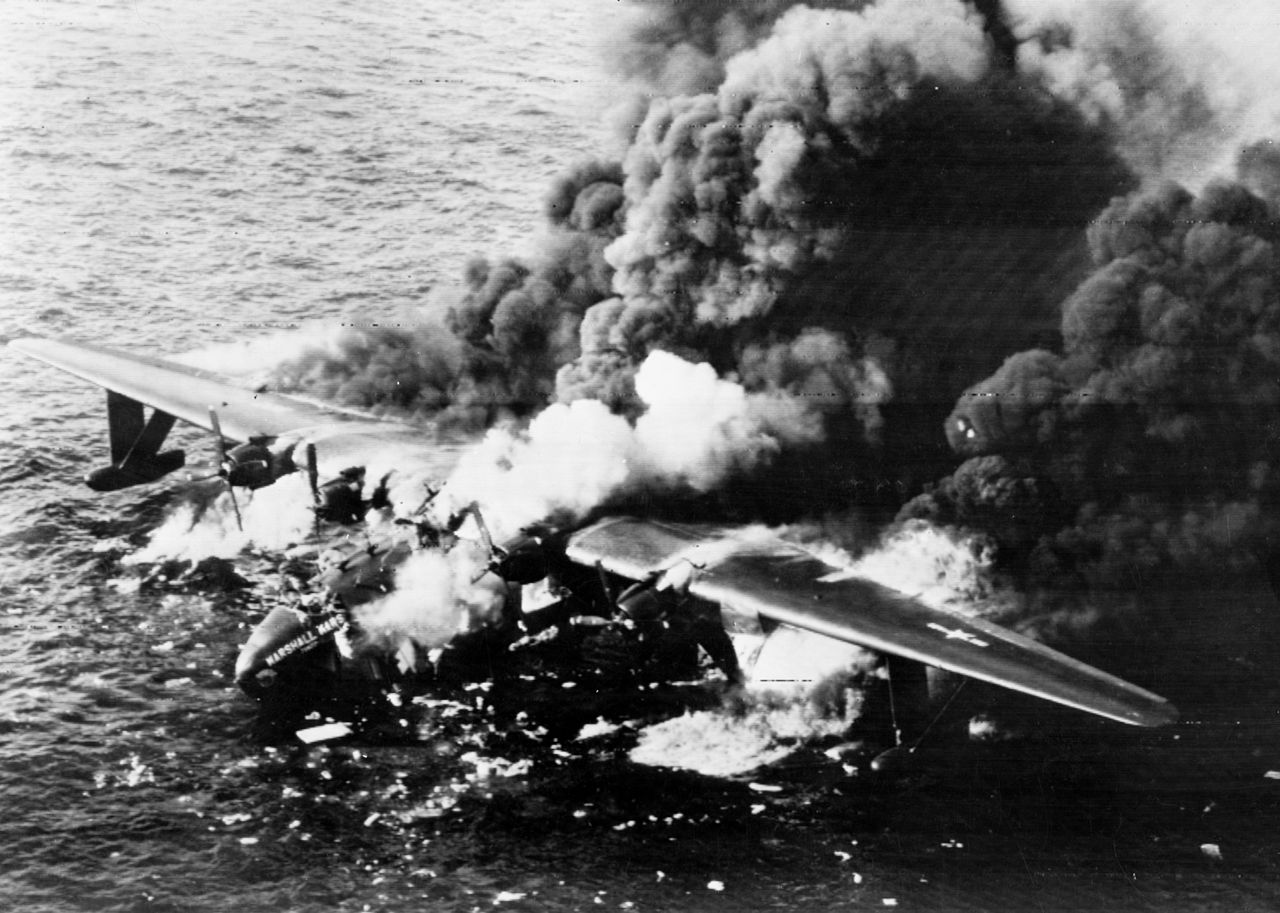
© 2020, Bryan R. Swopes